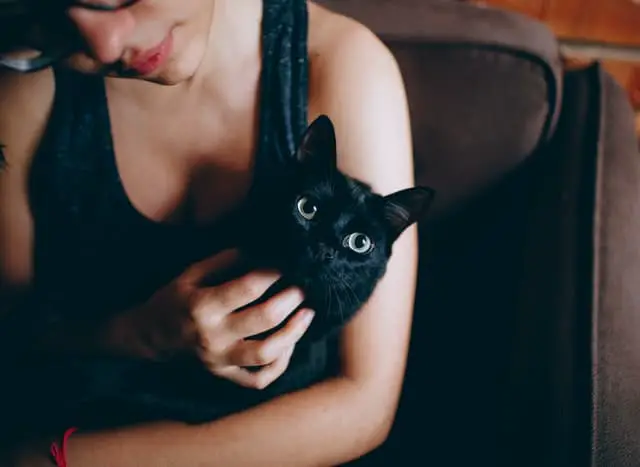
Have you ever heard of this practice? Everything you need to know about the practice of Reiki on cats and all its benefits.
The practice of Reiki has also been tested on our animal friends, because they have found really positive effects on their health. But it is not so obvious that the feline agrees to undergo this practice, since the last word must always be his! In fact, it will not be necessary to force them to accept this practice, but to make them passionate about this treatment, almost of their own free will, driven by their innate curiosity. Let’s find out some more information about the practice of Reiki and how it helps our cat to feel better.
Reiki: what it is
What do we know about this practice? Before understanding the health benefits of cats but also of other pets, it is important to have some more information about this treatment. It has Japanese origins and is used to treat both psychological and physical ailments. Therefore its beneficial effects are found above all on animals living in stressful and uncomfortable situations, often caused by the same humans with whom they live.
This holistic practice has its origins in Japanese culture, whose word is a compound of REI, which means spiritual, and KI, which means energy. The discipline of Reiki on cats has given rise to studies that have formed real experts in the sector, who in addition to knowing the techniques are also interested in understanding the best methods to approach animals. It is a natural healing and rebalancing energy system that infuses physical, mental and emotional harmony.
Given that our pets are often subjected to conditions of high stress at home, which can also create behavioral and psychological problems, with even permanent damage. With the help of this practice the vital functions of the cat are reactivated and set him on the path of a certain improvement.
Reiki: the precepts of its philosophy
Reiki sees living beings as sources of pure energy: the universe itself is a set of all these forces together. In short, it is energy that is stimulated in the cat, but first he must be intrigued: in fact, cats approach things that attract their attention. Once we get close we can think of practicing the discipline on them: some have to choose the place to undergo the treatment, others prefer to stay on the operator’s lap, others maybe stay where they are.
The practice of Reiki does not want to replace traditional medicine, but it could be excellent to combine with the most commonly used medical treatments. In fact, its role is not to replace, but to integrate and enhance the effects of traditional therapies, with enormous possibilities of healing and in shorter times.
How to put it into practice
Therefore, if the cat has decided to ‘be touched’ and has chosen the place to undergo the treatment, then the operator can place a hand on him. This first contact will be essential to understand how and if the cat accepts this stimulation and of course the subsequent ones. It is not certain that only one cat at a time can undergo the treatment, but also more than one cat at the same time. The hands must be placed together on the sides of the cat’s body, or one on the chest and one on the back, or on the head and back.
When will we have understood that it is time to finish the treatment? When the cat wakes up, or simply by moving away from the place where the practice began. In reality it is also the operator’s ability to understand how the cat reacts to the practice and if it is appropriate to stop or continue, without forcing it in any way. If the cat liked the treatment he could thank you with a cuddle, for example a lick.
The treatment should be operated for about 10-15 minutes every 3-4 hours, if the cat’s situation is particularly critical. In fact, cats often undergo the practice in the last hours of life, just to give them a little comfort in suffering.
Is Reiki only recommended for cats and dogs?
Our most common pets have now extended their boundaries to the ‘simple’ specimens of dogs or cats: unfortunately, and often our fault, all those who live with us can suffer stress and nervousness. In fact, physical and behavioral disorders often derive from emotional imbalances. Certainly Reiki has given excellent results to dogs and cats, but other animals have also been subjected to the same practice: even goldfish and tropical ones have enjoyed the benefits. Of course the operator placed his hands on the aquarium and not directly on their body. The same goes for birds in their cages or aviaries. Thanks to the Reiki treatment, animals calm down and regain energy.
What is Reiki for
Being an absolutely non-invasive practice, many are convinced to subject their little pets to it. It reduces pain and increases the chances of healing, as well as the times: even in animals that have undergone an operation it seems that Reiki gives excellent results. Unfortunately it can also be used in the last hours of life of the little friend who is about to die. What is needed is a quiet, noise-free space, and roomy enough for the pet to move freely if he wants to.
To subject the animals to the practice it will be necessary to establish a relationship of trust and harmony with them. Usually animals appreciate this practice, indeed they spontaneously undergo it, often showing the part of the body that hurts and would like to be healed. In short, he himself will make us understand where he wants us to put our hands to heal and feel relief.
If it is a wound, it is usually better not to touch it so as not to increase the sensation of pain, but it will be enough to bring the hands to the detached part of a couple of centimeters. Otherwise the animal could associate the pain with our hands and lose faith in us, not letting itself be touched anymore.
When is Reiki useful for cats?

If our beloved feline has some symptoms then we could think of intervening, in addition to the traditional medicine recommended by the trusted veterinarian, even with a Reiki practice. The cat in need has bruises or injuries if the cat has been poisoned or is suffering from anxiety attacks or has other cat-like compulsive disorders. If the treatment ends with cuddles and caresses, the cat will certainly receive great benefit. In fact, it’s also a way to make them feel loved and the center of attention.






